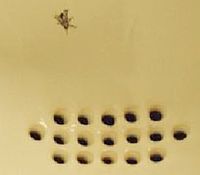
Photo from wikipedia
Abstract Understanding friction behavior of human skin is indispensable in order to optimize surfaces and materials in contact with the skin. The coefficient of friction (COF) for different materials contacting… Click to show full abstract
Abstract Understanding friction behavior of human skin is indispensable in order to optimize surfaces and materials in contact with the skin. The coefficient of friction (COF) for different materials contacting against the skin is mainly influenced by the nature of the materials, mechanical contact parameters, and physiological skin conditions. The aim of the present research work was to study the grip effect of two different polymeric materials by producing different textured patterns using a 3D printing microfabrication technique and a replication technique. It was found that under the same contact conditions, a difference in the friction amplitude exists between the two different polymeric materials and that positive texturing, which consists of high relief or protrusions, showed higher COFs than negative texturing, consisting of low relief, holes, or dimples, which showed a decrease in friction as the textured pattern area density increased.
Journal Title: Tribology Transactions
Year Published: 2019
Link to full text (if available)
Share on Social Media: Sign Up to like & get
recommendations!